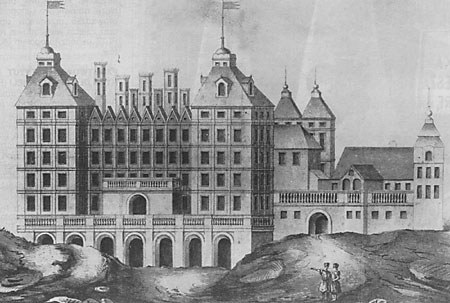- Kazanowski Palace
Infobox Historic building

caption=17th century image.
name=Kazanowski Palace
location_town=Warsaw
location_country=Poland
architect=Constantino Tencalla
client=Adam Kazanowski
engineer=
construction_start_date=1628
completion_date=1643
date_demolished=1656
cost=
structural_system=
style=Baroque |The Kazanowski Palace ( _pl. Pałac Kazanowskich), also known as the Radziejowski Palace, was a large palace in
Warsaw , occupying the place where the Charitable Center "Res Sacra Miser" stands today.History
When prince Władysław Vasa (future
Władysław IV of Poland ) became an adolescent, his fatherSigismund III Vasa bought him a Bobola's wooden mansion at theKrakowskie Przedmieście in Warsaw. Shortly after his return in1628 from a journey toWestern Europe the prince orderedConstantino Tencalla , royal architect, to build him a new palace in Italian style. Tencalla created one of the most wonderful palaces ever built in Warsaw.In
1632 the prince gave the palace to his favourite,Adam Kazanowski , which caused serious a misunderstanding with the King, and a specialSejm select committee was appointed to elucidate the situation. In1637 Kazanowski rebuilt and enlarged the building according to Tencalla's design.It was a large four-storied palace with a garden, enormous terrace and central courtyard. The
alcove tops were decorated with a gilded crowns. The rich furnishings of the palace were described in1646 byJean Le Laboureur , a companion of anambassador extraordinary of France to Poland, Madame de Guébriand. He was amazed by what he saw – a largeBacchus sitting on a barrel on wheels made of pure silver, which served as a wine vessel during the solemn banquets, gilded wooden ceilings in Venetian style filled withoil painting s,marble s, Flemish and oriental tapestries, master paintings, oriental-style treasures, precious furniture fromItaly andAugsburg , silverware, abear in a gilded cage in the front courtyard, and a large collection of musical instruments belonging to Crown Court Marshal Kazanowski's private orchestra.After Kazanowski's death the palace was passed on to his wife
Elżbieta Słuszczanka , who some time later marriedHieronim Radziejowski . She was the wealthiest woman in theRzeczpospolita , and when she became bored with Radziejowski demanded a divorce, which caused a small private war in Warsaw between Radziejowski and theSłuszka family.The rich Kazanowski Palace was ransacked and burned down during the Deluge in 1656 and was never rebuilt.
References
*Lileyko Jerzy, "Życie codzienne w Warszawie za Wazów", Warszawa, 1984. ISBN 8306010213
*"Warszawa w latach 1526-1795" t. II, red. Stefan Kieniewicz, Warszawa, 1984. ISBN 8301033231ee also
*
Marywil
*Marymont External links
*pl icon [http://www.warszawa1939.pl/index.php?r1=krakowskie_62&r3=0 www.warszawa1939.pl]
Wikimedia Foundation. 2010.
